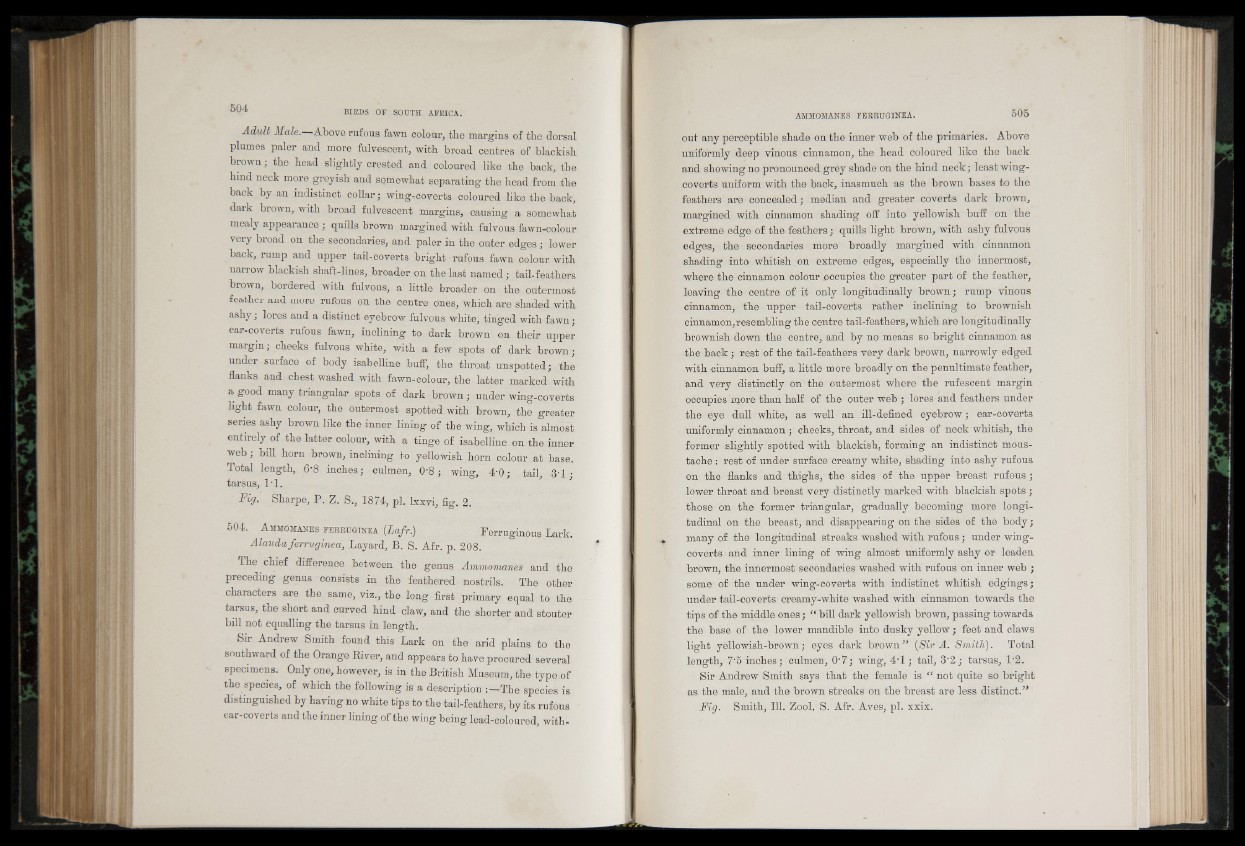
Adult Male. Above rufous fawn colour, tbe margins of the dorsal
plumes paler and more fulvescent, with broad centres of blackish
brown; the head slightly crested and coloured like the back, the
hind neck more greyish and somewhat separating the head from the
back by an indistinct collar; wing-coverts coloured like the back,
dark brown, with broad fulvescent margins, causing a somewhat
mealy appearance ; quills brown margined with fulvous fawn-colour
very broad on the secondaries, and paler in the outer edges ; lower
back, rump and upper tail-coverts bright rufous fawn colour with
narrow blackish shaft-lines, broader on the last named; tail-feathers
brown, bordered with fulvous, a little broader on the outermost
feather and more rufous on the centre Ones, which are shaded with
ashy; lores and a distinct eyebrow fulvous white, tinged with fawn •
ear-coverts rufous fawn, inclining to dark brown on their upper
margin; cheeks fulvous white, with a few spots of dark brown;
under surface of body isabelline buff, the throat unspotted; the
flanks and chest washed with fawn-colour, the latter marked with
a good many triangular spots of dark brown; under wing-coverts
light fawn colour, the outermost spotted with brown, the greater
series ashy brown like the inner lining of the wing, which is almost
entirely of the latter colour, with a tinge of isabelline on the inner
web; bifl horn brown, inclining to yellowish horn colour at base.
Total length, 6-8 inches; culmen, 0 8 ; wing, 4-0; .tail, 3T ;
tarsus, l 'l .
Fig, Sharpe, P. Z. S., 1874, pi. Ixxvi, fig. 2.
504. A h o m a n k f e r r u g t n e a (Lafr.) Ferruginous Lark.
Alauda ferruginea, Layard, B. S. Afr. p. 208.
The chief difference between the genus Ammomanes and the
preceding genus consists in the feathered nostrils. The other
characters are the same, viz., the long first primary equal to the
tarsus, the short and curved hind claw, and the shorter and stouter
bill not equalling the tarsus in length.
Sir Andrew Smith found this Lark on the arid plains to the
southward of the Orange River, and appears to have procured several
specimens. Only one, however, is in the British Museum, the type of
the species, of which the following is a description :—The species is
distinguished by having no white tips to the tail-feathers, by its rufous
ear-coverts and the inner lining of the wing being lead-coloured, without
any perceptible shade on the inner web of the primaries. Above
uniformly deep vinous cinnamon, the head coloured like the back
and showing no pronounced grey shade on the hind neck; least wing-
coverts uniform with the back, inasmuch as the brown bases to the
feathers are concealed; median and greater coverts dark brown,
margined with cinnamon shading off into yellowish buff on the
extreme edge of the feathers; quills light brown, with ashy fulvous
edges, the secondaries more broadly margined with cinnamon
shading into whitish on extreme edges, especially the innermost,
where the cinnamon colour occupies the greater part of the feather,
leaving the centre of it only longitudinally brown; rump vinous
cinnamon, the upper tail-coverts rather inclining to brownish
cinnamon,resembling the centre tail-feathers, which are longitudinally
brownish down the centre, and by no means so bright cinnamon as
the back; rest of the tail-feathers very dark brown, narrowly edged
with cinnamon buff, a little more broadly on the penultimate feather,
and very distinctly on the outermost where the rufescent margin
occupies njore than half of the outer web ; lores and feathers under
the eye dull white, as well an ill-defined eyebrow; ear-coverts
uniformly cinnamon; cheeks, throat, and sides of neck whitish, the
former slightly spotted with blackish, forming an indistinct moustache
: rest of under surface creamy white, shading into ashy rufous
on the flanks and thighs, the sides of the upper breast rufous ;
lower throat and breast very distinctly marked with blackish spots ;
those on the former triangular, gradually becoming more longitudinal
on the breast, and disappearing on the sides of the body;
many of the longitudinal streaks washed with rufous; under wing-
coverts and inner lining of wing almost uniformly ashy or leaden
brown, the innermost secondaries washed with rufous on inner web ;
some of the under wing-coverts with indistinct whitish edgings;
under tail-coverts creamy-white washed with cinnamon towards the
tips of the middle ones; “ bill dark yellowish brown, passing towards
the base of the lower mandible into dusky yellow; feet and claws
light yellowish-brown; eyes dark brown” (Sir A. Smith). Total
length, 7'5 inches; culmen, 0 7 ; wing, 4’1 ; tail, 3-2 ; tarsus, 1*2.
Sir Andrew Smith says that the female is “ not quite so bright
as the male, and the brown streaks on the breast are less distinct.”
Fig. Smith, 111. Zool. S. Afr. Aves, pi. xxix.